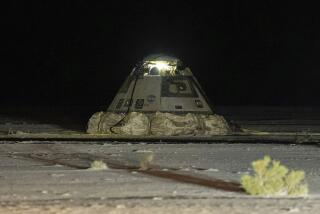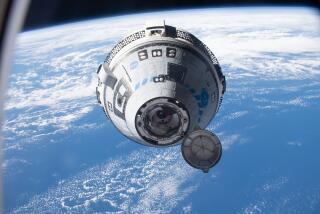NASA Says Discovery Is Clear for Landing
HOUSTON — After deciding against a fourth spacewalk to repair a bulging insulation blanket, NASA on Thursday cleared the space shuttle Discovery for landing, declaring the danger to the seven crew members to be remote.
Officials said wind-tunnel testing showed that even if a piece of the torn blanket came off, there would be only a 1.5% chance a piece would strike the craft, which is scheduled to return to Earth on Monday.
“If anything does come off, it will be very small ... less than an ounce,” said N. Wayne Hale Jr., deputy shuttle program manager. “We feel we are good to fly as is.”
Hale cautioned that some risk remained. A worst-case scenario showed it is possible that a 0.8-ounce piece of the ceramic-coated blanket material could flake off and tear a 6-foot hole in Discovery’s rudder area.
Even if that happened, Hale said, engineers believed the crew could maintain control of the vehicle. Given the forces involved, the piece of blanket would only come off at subsonic speeds between five and 10 minutes before landing, meaning the object would hit with much less force than if it came off when the craft reentered Earth’s atmosphere at speeds approaching 17,500 mph.
The crew learned of the decision to forgo a fourth spacewalk to repair the blanket as they were heading for bed at the end of the 10th day of a 14-day mission to resupply the International Space Station.
“That’s, I would say, good news,” said Japanese astronaut Soichi Noguchi, who would have been one of the two astronauts chosen to make the repair.
The blanket is the latest problem to surface on this flight, the first since the shuttle Columbia broke apart on reentry in 2003.
During launch, a large piece of insulating foam came off the external fuel tank, causing NASA to ground the shuttle fleet until it fixes the foam-shedding problem, which doomed Columbia.
After discovering two spacers, or “gap fillers,” protruding between the heat-resistant silica tiles on Discovery’s underside, engineers recommended a spacewalk to remove them.
Next came the problem with the blanket, one of 32 lightweight, quilted pieces of fabric affixed to the upper areas of the orbiter to offer additional heat protection during launch and landing.
There were no good options to repair the damage without making it worse, Hale said. Proposed solutions included cutting off the fraying portion or trying to remove the entire blanket.
Three wind-tunnel tests Wednesday and Thursday at the Ames Research Center near Mountain View, Calif., were vital to reaching the final decision.
“Some strings of quilting came undone, but by and large the blanket was intact,” Hale said.
NASA still does not know what caused the rupture. Some speculate the 20-by-4-inch tear could have been caused by hitting a bird on liftoff or by paper thruster covers that may have struck the craft.
Some critics have said the glitches prove the shuttle orbiter is unsafe and should not fly.
NASA has said that despite the known problems, fewer things have plagued the Discovery flight than in many past missions. The difference is that in the past, divots and dings to the orbiter were not discovered until after landing, when only the maintenance workers were paying attention.
These glitches are playing out in full view of the world.
After the Columbia accident, NASA added an array of sensors and cameras to reveal potential dangers before exposing the crew to the brutal aerodynamic forces of reentry.
The preoccupation with glitches on Discovery’s flight, however, has caused some former NASA hands to accuse the agency of becoming overly cautious about issues once regarded as inconsequential.
“We are not in analysis paralysis by any stretch of the imagination,” Hale said.
While engineers on the ground have been working long hours, the crew has carried out its planned tasks, he said.
On Thursday, the astronauts finished unloading trash from the space station to Discovery for transport back to Earth.
They also recorded a series of messages in honor of Columbia’s crew. Several chose to read poetry or quote from speeches, such as Wendy Lawrence’s recitation of President Kennedy’s remarks. “Space is there, and we’re going to climb it,” she said. “We do these things not because they are easy but because they are hard.”
More to Read
Sign up for Essential California
The most important California stories and recommendations in your inbox every morning.
You may occasionally receive promotional content from the Los Angeles Times.










